Executive Summary
Business Name & Location. BrightNest Cleaning Solutions LLC — Metro Atlanta, Georgia (serving Gwinnett, Fulton, DeKalb, Cobb).
Business Concept. BrightNest delivers residential and commercial cleaning with a simple promise: we show up on time, follow a clear checklist, and leave spaces better than we found them. Core services include recurring home cleaning, deep cleans, move-in/move-out, post-construction, and specialty work (carpet, interior windows, disinfection). Operations run on disciplined processes: vetted crews, photo-verified quality control, online booking, predictable pricing, and a 48-hour re-clean guarantee. In plain English: no drama, clean floors, clear invoices.
Mission Statement. Save clients time and mental bandwidth by providing consistent, eco-forward cleaning delivered by trained people who take pride in the craft.
Vision Statement. Within five years, be the most trusted “smart cleaning” brand in Metro Atlanta—recognized for punctuality, measurable quality, and a scalable playbook sturdy enough to franchise.
Ownership & Legal Form. Limited Liability Company (LLC) owned by two operator-founders (CEO and COO). Insurance, workers’ compensation, and janitorial bond maintained; standard local licensing in place.
Highlights / Key Metrics.
| Metric | Target / Projection | Notes |
|---|---|---|
| Total startup budget | $35,000 | Vehicles/branding, equipment & supplies, insurance, website/marketing, working capital |
| Year-1 revenue | $320,000 | ~60% recurring residential, ~30% commercial, ~10% specialty |
| Year-1 gross margin | 46–50% | Standardized scopes, route optimization |
| Year-1 net margin | 15–17% | Lean overhead; performance-driven spend |
| Break-even | Month 5–6 | At ~220 residential jobs/month or a mixed book with 8–10 SMB office contracts |
| Recurring retention (6 months) | ≥ 80% | Loyalty credits + 48-hour re-clean policy |
| On-time arrival SLA | ≥ 95% | $25 credit if we miss the window by >15 minutes |
Funding Requirement. Seeking $26,500 in external capital (founders’ equity committed: $8,500) to complete the $35,000 launch. Use of funds: equipment & supplies ($7,000), vehicle/branding ($15,000), insurance & licenses ($3,500), website & initial marketing ($4,000), working capital ($5,500). Payback begins from free cash flow starting Month 7 under a standard term loan or revenue-share structure.
Brief Market Opportunity. Metro Atlanta’s growth, dense small-business footprint, and established demand for recurring home services create a durable base for a cleaning operator that is punctual, process-driven, and eco-conscious. Low asset intensity, subscription revenue, and upsell pathways (deep cleans, carpet, move-out) produce healthy unit economics when labor is scheduled tightly and quality variance is kept low.
Company Description
Company History / Background. BrightNest was formed in 2025 after the founders kept hearing the same client complaints: “they didn’t show,” “prices changed on the doorstep,” “quality depends on who shows up.” Our answer is boring on purpose—checklists, timing windows, photos, and fair pricing—because boring is exactly what clients want when it comes to cleaning.
Founding idea and motivation. The market isn’t short on cleaners; it’s short on predictability. We built BrightNest to deliver repeatable outcomes: trained crews, eco-forward products by default, and service standards that don’t wiggle.
Previous experience of founders.
- CEO: 10+ years in facilities and hospitality operations; scaled multi-site teams, ran QA programs tied to customer NPS, comfortable owning P&L and pricing strategy.
- COO: 7 years in field operations and safety; designed workflows, implemented OSHA-aligned training, and improved crew productivity without burning people out.
Legal registration date, location, licenses. Georgia LLC registered in 2025; local business license current; general liability and workers’ comp active; janitorial bond in place. Safety files include SDS for all chemicals and documented PPE policies.
Mission & Vision (Expanded)
Mission. Deliver dependable, health-conscious cleaning that respects clients’ time and space—through vetted staff, standardized scopes, and transparent commitments.
Vision. Build a scalable, data-driven platform for residential and light commercial cleaning in Metro Atlanta, then expand selectively once the playbook consistently hits on-time SLAs, QA pass rates, and target margins.
Business Objectives (SMART)
- Reach an annualized run-rate of $500,000 by Month 24 with net margin of ≥ 18%.
- Acquire 350 recurring residential clients and 15 SMB office contracts by end of Year 2.
- Maintain QA pass rate of ≥ 95% (no re-clean needed) and an average public rating of ≥ 4.7/5.
- Respond to new inquiries with quotes in < 2 business hours; first-visit lead time ≤ 3 days residential, ≤ 7 days commercial.
- Break even by Month 6; begin capital payback within 24–30 months from free cash flow.
Ownership & Management Team
- CEO (Owner-Operator): Strategy, finance, partnerships, key accounts.
- COO (Owner-Operator): Scheduling, field operations, training, QA, safety.
- Inspector / Float Lead (Year 1): Surprise QA checks, onboarding new crews, solving weird jobs without derailing the day.
- Office Coordinator (Year 1, H2): Dispatch, client communication, billing, and the gentle art of “no, that’s not included—here’s the add-on price.”
Organizational Chart (Initial)
| Role | Reports To | Headcount (Start) |
|---|---|---|
| CEO | — | 1 |
| COO | CEO | 1 |
| Inspector / Float Lead | COO | 1 |
| Cleaning Teams (2-person crews) | COO | 6 (3 crews) |
| Office Coordinator (H2) | CEO | 1 |
Company Values and Culture
- Professionalism: Uniforms, checklists, scoped quotes, and starting on time.
- Sustainability: Eco-friendly products by default; waste-reduction habits; smart routing to cut idle time.
- Customer care: 48-hour re-clean guarantee; clear SLAs; before/after photos so clients don’t have to guess.
- Trust & safety: Background checks, bonding, insurance, and common-sense boundaries on risky tasks.
- Continuous improvement: Field feedback loops, quick post-mortems when something slips, weekly refreshers for crews.
Industry and Market Analysis
Purpose. Map the U.S. cleaning landscape, quantify demand drivers, and show where BrightNest wins in Metro Atlanta.
Industry Overview
The U.S. janitorial and cleaning sector is large (roughly $100B+) and steady, with mid–single-digit growth after the pandemic surge settled. It’s highly fragmented: national franchises, regional operators, and a long tail of independents. Four durable trends matter for us: (1) eco-friendly products becoming the default, (2) recurring home subscriptions gaining share, (3) technology (apps/CRMs) standardizing booking, routing, and proof-of-work, and (4) elevated hygiene expectations in commercial spaces. Challenges revolve around labor tightness, low entry barriers, and customer retention — reliability and process discipline are the real moat.
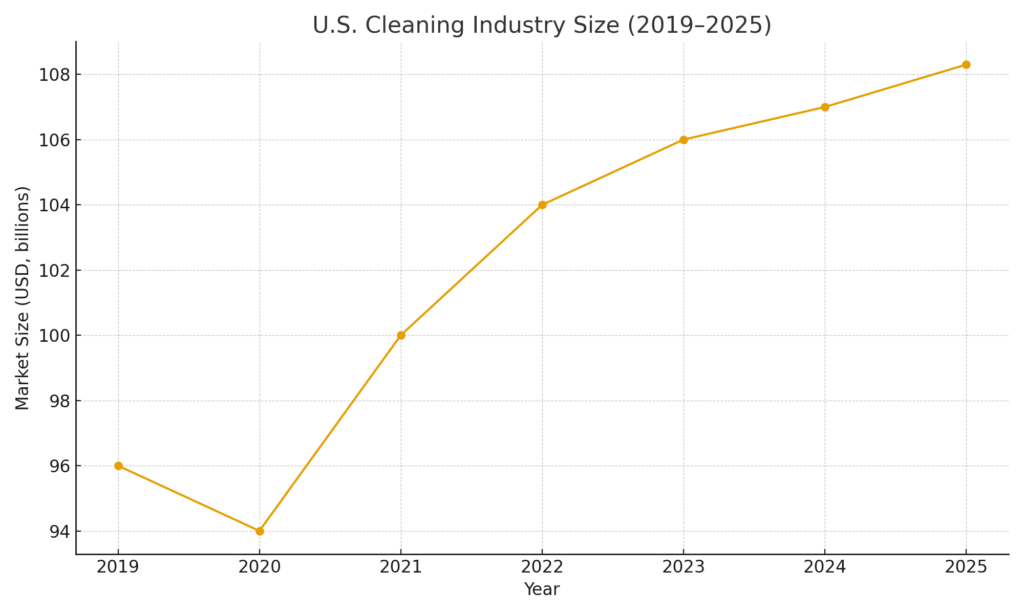
Market Size and Growth Potential
- National. Demand is diversified across residential and commercial end-users. Recurring revenue plus upsellable project work (deep cleans, move-outs, carpets) keeps operators resilient through cycles.
- Regional (Metro Atlanta). Fast-growing population and a dense base of small and midsize offices within short drive times. Suburban household growth supports weekly/biweekly schedules; light-commercial normalizes around smaller footprints but higher quality expectations (documentation, eco products).
- 5–10 year view. Expect steady, not flashy growth. The mix rewards operators who can maintain staffing, keep schedules tight, and document outcomes without friction.
Target Market
- Residential (weekly/biweekly/monthly). Dual-income, time-constrained households; mid- to upper-middle income; often pet-friendly and eco-minded. Pain points: no-shows, variable quality, surprise pricing. Win factors: on-time SLA, clear scopes, photo-verified completion.
- SMB offices/clinics (nightly to 3×/week). 10–40 employees; front-of-house and restrooms matter most. Pain points: missed nights, weak communication, no proof of work. Win factors: checklists, logs, before/after photos, responsive fix-it loop.
- Property managers/realtors (move-in/out under 48–72h). Speed and consistency > rock-bottom price. Win factors: rapid scheduling, documented scope, photos for files.

Competitive Analysis
Landscape. National franchises (tight playbooks, higher price floors), regional multi-location operators (decent coverage, uneven QA), independents/solo cleaners (price-competitive, reliability gaps). BrightNest positions as process-driven, mid-price, eco-first — with visible proof of work.
| Strengths | Weaknesses | Opportunities | Threats |
|---|---|---|---|
| On-time SLA; standardized scopes; photo-verified QA; eco by default; human, courteous service | New brand; initial coverage limited to core counties | Subscription growth; light-commercial reopenings; upsells (deep, carpet, move-out) | Low-cost entrants; wage inflation; schedule volatility from client churn |
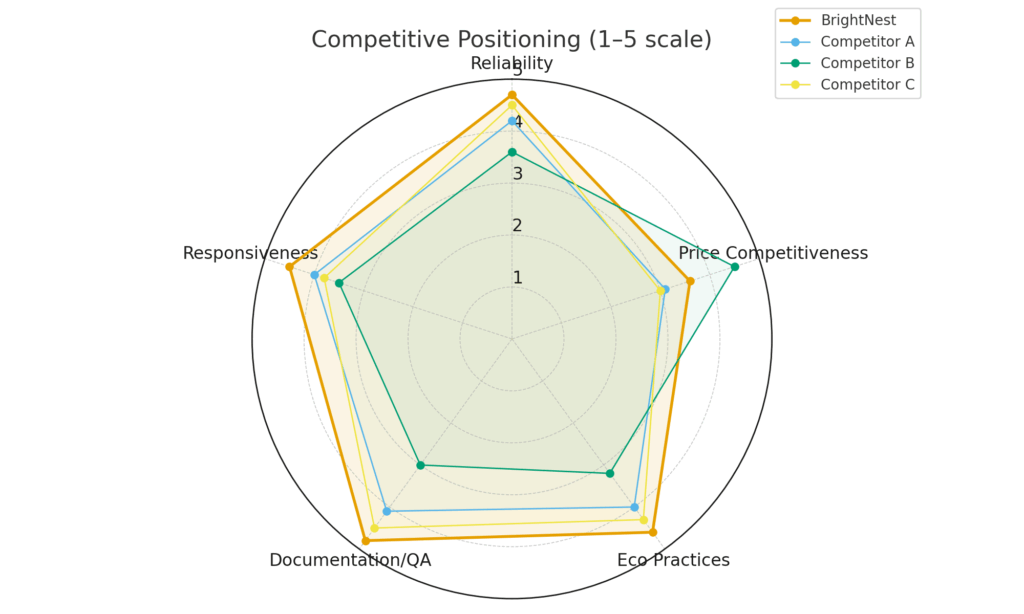
Market Gaps & Opportunity
- Reliability gap. Too many providers miss arrival windows or change scope mid-job. We lock reliability with defined windows, written checklists, and a simple “credit if late” policy.
- Proof gap. Clients rarely see tangible evidence of work. We attach before/after photos and short notes to every job — no debate, just proof.
- Niche depth. Pet-friendly protocols, front-of-house medical/dental with documented disinfection, and subscription bundles with seasonal deep cleans — all under eco-forward defaults that clients increasingly prefer.
Products and Services
Purpose. Spell out exactly what we sell, how it’s packaged, and why it’s worth the money.
Service Categories
- Residential Cleaning — standard (weekly/biweekly/monthly), deep, move-in/move-out.
- Commercial Cleaning — offices, retail/showrooms, post-construction/light industrial common areas.
- Specialty Cleaning — carpet & upholstery extraction, interior windows (≤2nd floor), disinfection.
- Green Cleaning — non-toxic products by default; hospital-grade options on request.
Service Packages / Pricing Strategy
- Pricing model. Flat-rate menus for common scopes; hourly crew rate for open-ended projects; discounts for recurring schedules.
- Promotions. First-time deep-clean credit toward a recurring plan; referral credits; quarterly add-on bundles (fridge/oven/windows).
| Service Type | Price Range (USD) | Frequency |
|---|---|---|
| Standard Home Cleaning (up to 2 bed / 2 bath) | $140–$180 per visit | Weekly / Biweekly |
| Deep Clean (3 bed / 2 bath) | $280–$380 per job | Quarterly / As needed |
| Move-In/Move-Out (1,500–2,000 sq ft) | $320–$480 per job | Project |
| Office Cleaning | $0.16–$0.28 per sq ft / month | Monthly contract |
| Carpet Extraction | $0.18–$0.30 per sq ft | As scheduled |
Unique Value Proposition (UVP)
- On-time or we credit you. Miss the arrival window by >15 minutes? $25 credit. No excuses.
- Photo-verified QA. Before/after pics attached to each job—everyone sees the same truth.
- Eco by default. Non-toxic products unless the job clearly needs something stronger (then we explain and get consent).
- 48-hour re-clean guarantee. If we miss, we fix. Fast.
Supplier and Partner Relationships
- Supplies & equipment. Regional jan-supply vendors for chemicals, microfiber, liners; commercial vacuums (HEPA), carpet extractors, floor machines.
- Service partners. Vehicle branding, laundry services for microfiber, equipment maintenance shops.
- Sustainability. Preference for concentrated, refillable products; SDS maintained; waste-reduction practices.
Marketing and Sales Strategy
Purpose. Attract the right customers, convert them fast, and keep them long enough that the unit economics sing.
Market Positioning
- Position: Mid-price, process-driven operator with eco-forward defaults and visible proof of work.
- Customer promise: On time, on scope, photo-verified. If we miss, we fix (48-hour re-clean) and credit if late (>15 min).
- Brand tone: Professional without fluff; plain talk, clear quotes, no surprise add-ons.
Customer Acquisition Strategy
Online channels.
- Website & booking: Clear packages, instant quote form, real-time calendar windows, deposits for first-time jobs.
- Google Business Profile: Local categories + service areas, photo posts 2×/week, review request after each job, response < 24h.
- Local SEO: City/neighborhood landing pages (residential, office, move-out); FAQs that mirror real objections; before/after galleries.
- Paid search (starter): Branded + intent keywords (e.g., “house cleaning near me”, “office cleaning [city]”); target blended CAC ≤ $85 in first 90 days, ≤ $65 by Month 6.
- Content & video: Short “what’s included” clips, cleaning checklists, seasonal deep-clean guides; repurpose to social.
- Social (Facebook/Instagram/Nextdoor): Before/after swipes, crew spotlights, limited-time bundles; local community replies same day.

Offline channels.
- Realtor & property manager network: Move-in/out SLAs (48–72h), photo sets for files; volume pricing after 5th job/month.
- Local partnerships: Dentist/clinic front-of-house, fitness studios, coworking spaces; small sponsorships with service credits.
- Flyers & door drops: Tight radius around active routes; unique codes to track redemption and CAC.
| Channel | Monthly Spend (Start) | Leads/mo | Lead→Book | CAC | Notes |
|---|---|---|---|---|---|
| Google Ads | $2,000 | 120 | 25% | $67 | High intent; strict negative keywords |
| Local SEO | $800 | 60 | 22% | $60 | Content + GBP optimization |
| Realtor/PM referrals | $300 | 20 | 40% | $38 | Move-in/out gateway to recurring |
| Social (paid + organic) | $600 | 35 | 18% | $95 | Great for promos/seasonal |
| Door drops | $300 | 25 | 16% | $75 | Only along existing routes |

Customer Retention Strategy
- Loyalty: 5% off biweekly, 10% weekly; quarterly deep-clean bundle at a member rate.
- Referral: $25 credit to both parties after second completed job; stackable up to one free clean/quarter.
- Post-service loop: SMS survey < 24h; “issue” → re-clean in 48h; “great” → review link.
- Proactive care: Auto-nudges for filters, grout, carpets at reasonable intervals; simple “skip/pause” controls to cut churn.
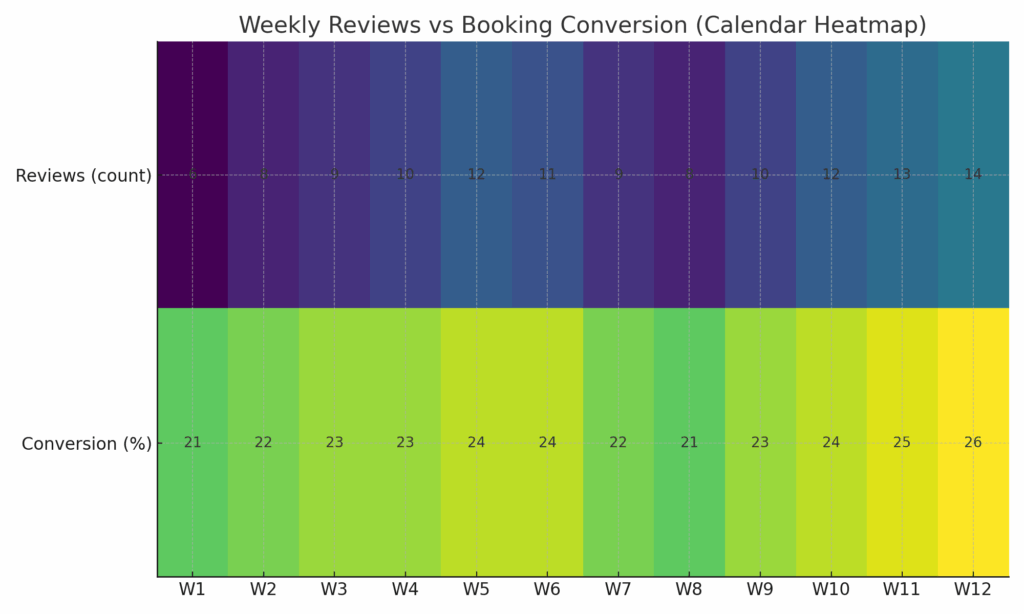
| Retention KPI | Target | Mechanism |
|---|---|---|
| 6-mo recurring retention | ≥ 80% | Loyalty + consistent crew pairing |
| NPS / Avg rating | ≥ 70 / ≥ 4.7 | Re-clean guarantee; fast fixes |
| Skip rate (per cycle) | ≤ 10% | Flexible rescheduling windows |
Sales Funnel
- Awareness → Interest → Booking → Repeat. Fast quotes (< 2 business hours), deposits for first-timers, upsell add-ons at confirmation (fridge, oven, windows).
- Tools: CRM for pipeline stages, automated reminders (quote follow-ups at +1h/+24h), abandoned-quote nudge with small credit.
- Benchmarks: Lead→book 20–25% (residential), 15–20% (commercial RFPs); upsell attach rate 20%+ by Month 6.
Branding Strategy
- Visuals: Clean logo, uniforms, simple vehicle marks; avoid busy wraps.
- Consistency: Same headline promise across site, quotes, invoices.
- Trust elements: Before/after photos, clear scope tables, re-clean policy front and center.
Operations and Management Plan
Purpose. Keep days predictable: tight schedules, clear scopes, safe work, and zero-drama handoffs.
Operational Workflow
- Intake & Quote. Website form or call → scope checklist → fixed price or hourly crew rate → deposit (first-time).
- Scheduling. Slot into nearest route; crew pairing stays consistent; SMS window confirmation.
- Service. Arrival photo, room-by-room checklist, exceptions noted in app; supervisor pings if scope drifts.
- QA & Handoff. Before/after photos; client walk-through (if present); invoice sent same day.
- Follow-up. Survey < 24h; re-clean if needed within 48h; review request when green.
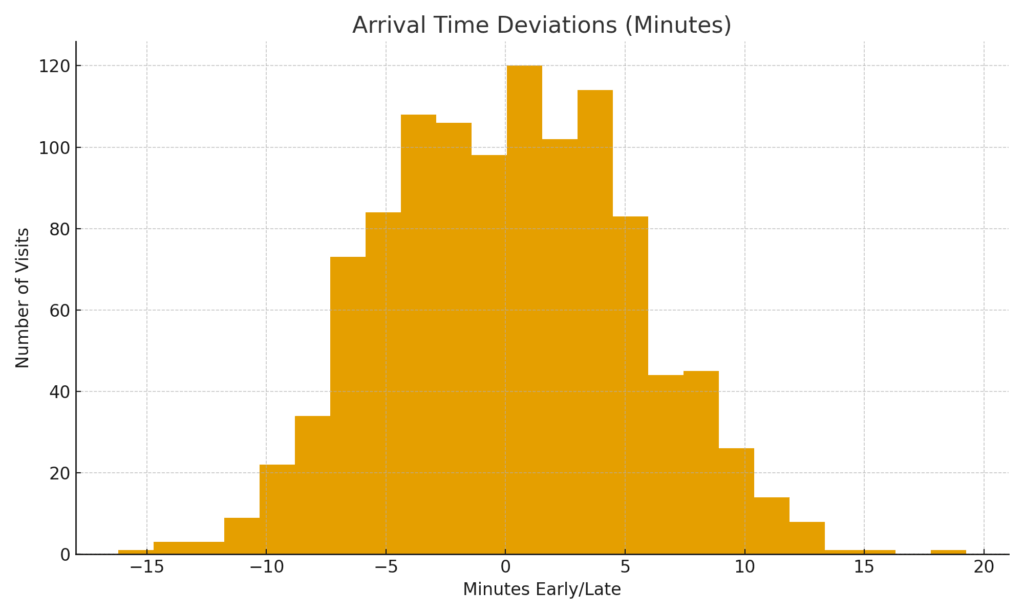
| SLA / Control | Target | Owner |
|---|---|---|
| On-time arrival | ≥ 95% | COO / Dispatch |
| Quote response time | < 2 business hours | Office Coordinator |
| QA pass (no re-clean) | ≥ 95% | Inspector |
| First-visit lead time | ≤ 3 days (res), ≤ 7 days (comm) | Scheduling |
Location and Facilities
- Base: Small office + storage for supplies and equipment; central to core counties.
- Fleet: Initial 2 vehicles (crews rotate), 1 spare day per week for maintenance.
- Inventory: Color-coded microfiber, HEPA vacuums, standardized chemicals; weekly par levels and reorder points in CRM.
Technology and Tools
- CRM/Booking: Jobber/Housecall Pro with online quotes, deposits, reminders, and photo attachments.
- Routing & Timekeeping: App GPS + Google Maps optimization; clock-in/out on job site.
- Accounting/Payroll: QuickBooks Online + Gusto; job-costing tags by client and service type.
- Safety & SDS: Digital SDS library; in-app safety checklists per service type.

Staffing and HR Plan
- Headcount (start): 3 two-person crews (6 cleaners) + 1 inspector/float. Office coordinator hired in H2.
- Hiring: Background checks, work sample shift, reference calls. Target time-to-hire: ≤ 10 days.
- Training: 15 hours onboarding (chemicals/PPE, room-order method, client etiquette), quarterly refreshers.
- Comp: Base $17–$20/hr + performance bonus tied to QA, on-time, and client ratings.
- Safety: OSHA basics, lift limits, chemical labeling, glove/eye protection, incident reports within 24h.
| Capacity Model | Per Crew | Total (3 Crews) | Notes |
|---|---|---|---|
| Homes/day (standard) | 3–4 | 9–12 | 2.5–3.0 hrs/home incl. drive |
| Office nightly sq ft | 7–9k | 21–27k | Light janitorial, not heavy industrial |
| Utilization target | 82–86% | — | Slack for re-cleans & rush jobs |

Management Team
- CEO / Founder — Strategic planning, pricing, partnerships, finance, key accounts.
- Operations Manager (COO) — Scheduling, logistics, QA program, safety compliance, vendor relations.
- Marketing Lead (fractional, Y1) — Website, search, social, content calendar, tracking CAC/LTV by channel.
- Finance Officer (part-time/CPA) — Accounting, payroll oversight, monthly closes, cash-flow forecasts.
Financial Plan
Purpose. Put numbers to the story: what it costs to launch, what we expect to bring in, what it takes to run the machine without drama, and when the business throws real cash.
Startup Costs
One-time and pre-opening spend. No gold-plating; just what’s needed to deliver reliable work from day one.
| Category | Estimated Cost (USD) |
|---|---|
| Equipment & Supplies (vacuums HEPA, microfiber, chemicals, PPE, carts) | $7,000 |
| Vehicles & Branding (used compact cargo + marks) | $15,000 |
| Licensing, Insurance, Bond (GL, WC, auto, permits) | $3,500 |
| Website & Marketing (build, landing pages, initial ads) | $4,000 |
| Working Capital (float for payroll, fuel, supplies) | $5,500 |
| Total | $35,000 |
Revenue Projections
Model logic. Mixed book: recurring residential (weekly/biweekly), light commercial contracts, plus project work (deep cleans, move-outs, carpets). Three 2-person crews to start.
- Average tickets (blended): Residential $165/visit; Commercial baseline $0.22/sq ft/month contracts; Specialty varies ($0.18–$0.30/sq ft carpets, etc.).
- Year 1 mix (by revenue): 60% residential, 30% commercial, 10% specialty.
- Retention & cadence: target ≥80% 6-month retention on recurring residential; office contracts 12-month terms with 30-day out.
- Seasonality assumption (Year 1): Jan–Feb softer, spring/fall stronger; summer steady.
| Year | Total Revenue | Residential | Commercial | Specialty |
|---|---|---|---|---|
| Year 1 | $320,000 | $192,000 | $96,000 | $32,000 |
| Year 2 | $420,000 | $246,000 | $134,400 | $39,600 |
| Year 3 | $520,000 | $299,000 | $182,000 | $39,000 |
Year-1 monthly pattern (illustrative):
| Month | Rev (USD) | Notes |
|---|---|---|
| Jan | $27,200 | Post-holiday dip |
| Feb | $28,800 | Short month, steady |
| Mar | $30,400 | Spring ramp |
| Apr | $32,000 | Seasonal lift |
| May | $34,400 | Peak demand |
| Jun | $32,000 | Steady |
| Jul | $26,400 | Vacations; more move-outs |
| Aug | $25,600 | Back-to-school dip |
| Sep | $28,800 | Fall ramp |
| Oct | $32,000 | Peak |
| Nov | $30,400 | Pre-holiday |
| Dec | $22,000 | Holidays; shorter weeks |
| Total | $320,000 |
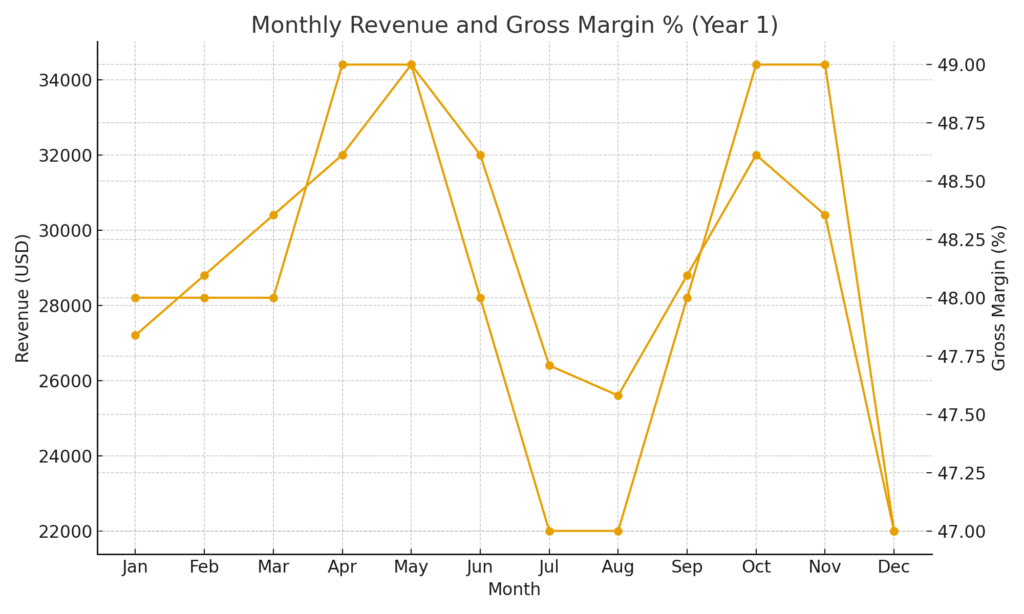
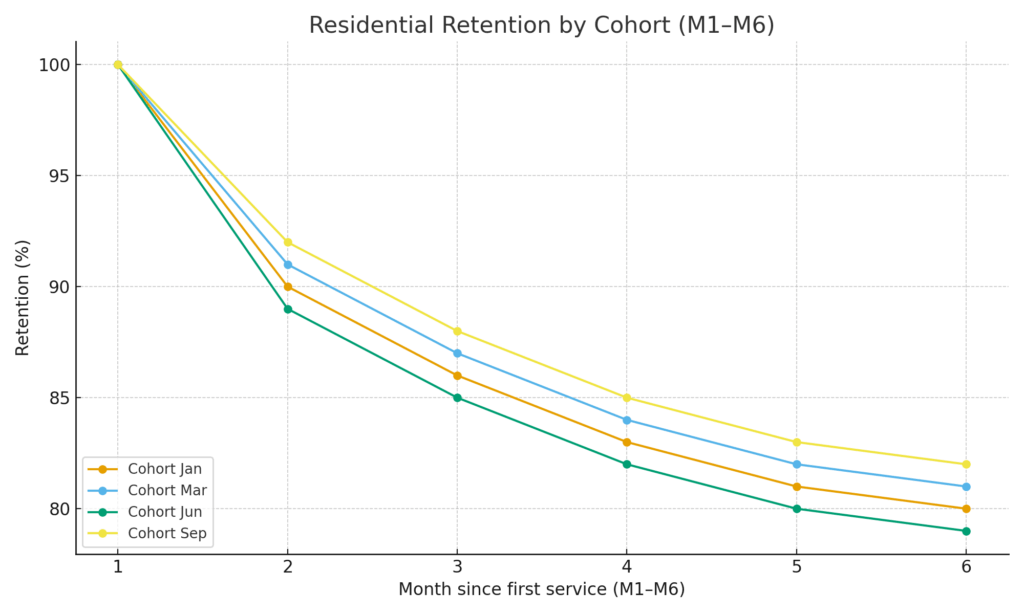
Expenses
Direct costs (COGS) – tied to revenue. We keep these tight; consistency beats heroics.
- Direct labor (cleaning crews): ~38% of revenue
- Payroll taxes & basic benefits on crews: ~8% of revenue
- Supplies & disposables: ~4% of revenue
- Fuel & route costs (variable portion): ~2% of revenue
COGS assumption Year 1: ~52% of revenue → gross margin ~48%.
Operating expenses (mostly fixed or semi-fixed).
- Rent & utilities: $900 + $200 / month
- Insurance (GL, WC, auto) & bond: ~$700 / month
- Software stack (CRM, routing, accounting): ~$300 / month
- Marketing (baseline): $2,000 / month (ads + content; separate from variable tests)
- Office Coordinator (H2 only): $1,500 / month for 6 months
- Owners’ draws (modest in Y1): ~$2,000 / month aggregate
- CPA/bookkeeping & compliance: ~$300 / month
- Vehicle fixed (non-fuel) & maintenance set-aside: ~$400 / month
- Training/PPE refreshers: ~$200 / month
Profit & Loss Forecast
Year 1 P&L (rounded):
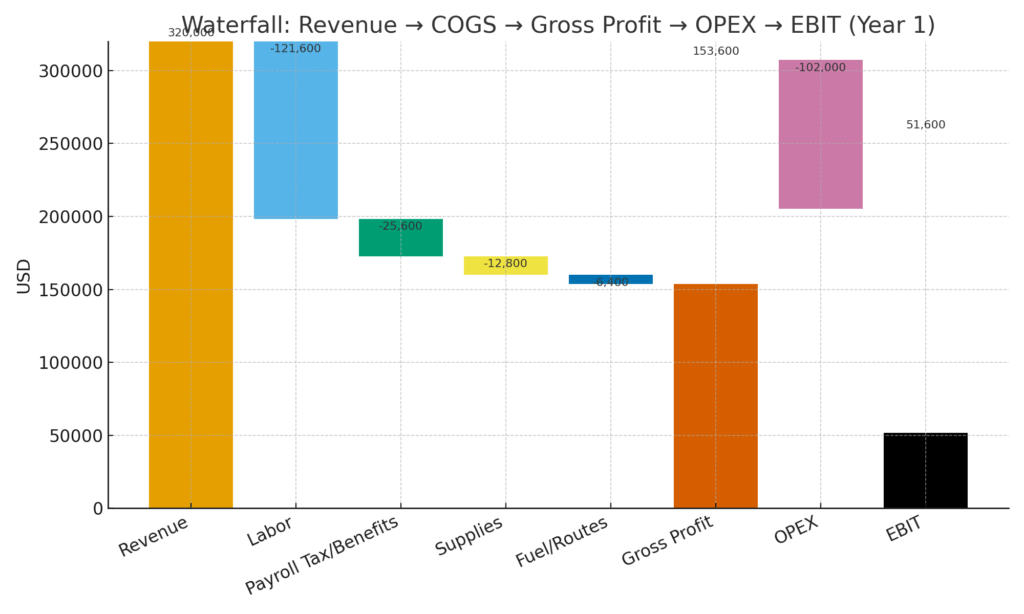
| Line | Amount (USD) | % of Revenue |
|---|---|---|
| Revenue | $320,000 | 100.0% |
| COGS (labor, payroll tax/benefits, supplies, variable fuel) | ($166,400) | 52.0% |
| Gross Profit | $153,600 | 48.0% |
| Operating Expenses (rent, insurance, software, baseline marketing, office, owners’ draw, CPA, vehicle fixed, training) | ($102,000) | 31.9% |
| Operating Income (EBIT) | $51,600 | 16.1% |
| Interest (if term loan) | ($2,000) | 0.6% |
| Pre-Tax Income | $49,600 | 15.5% |
Years 2–3 (high level, assuming controlled growth):
| Year | Revenue | COGS % | Gross Profit | Opex | Operating Income | Net Margin |
|---|---|---|---|---|---|---|
| Y2 | $420,000 | 51% | $205,800 | $126,000 | $79,800 | ~18–19% |
| Y3 | $520,000 | 50% | $260,000 | $150,000 | $110,000 | ~21% |
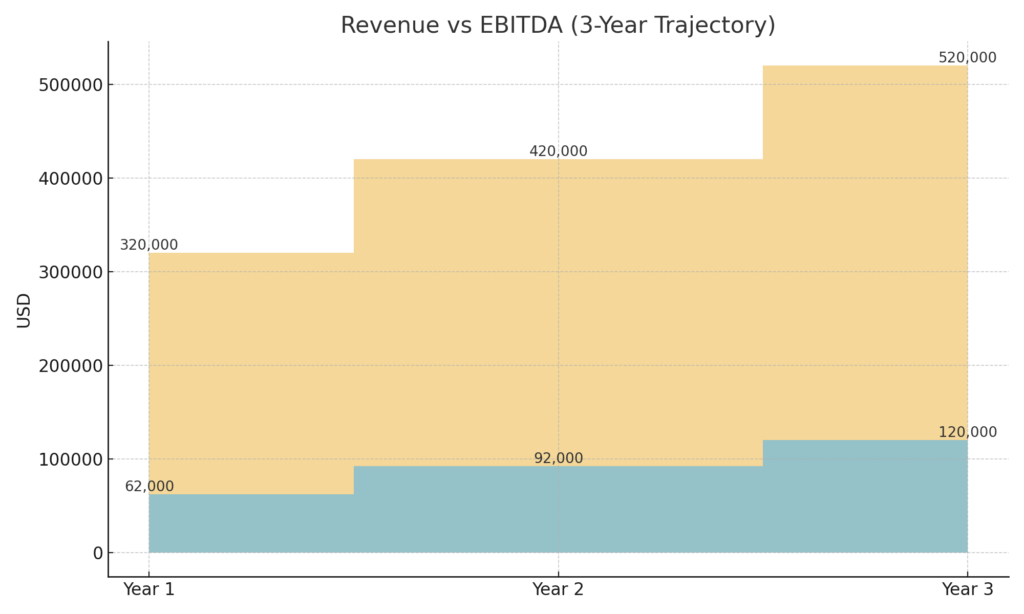
Notes: Opex rises, but slower than revenue as routes densify, repeat work increases, and marketing “learns.”
Cash Flow Forecast (Year 1)
Assumptions. Residential jobs pay at service (same-day). Commercial bills monthly net-15. Average collection cycle ≈ 7–10 days blended. Startup capex hits Month 0–1.
| Month | Cash In | Cash Out (COGS) | Cash Out (Opex) | Net Cash | End Cash* |
|---|---|---|---|---|---|
| Jan | $27,200 | ($14,144) | ($8,500) | $4,556 | $10,056 |
| Feb | $28,800 | ($14,976) | ($8,500) | $5,324 | $15,380 |
| Mar | $30,400 | ($15,808) | ($8,500) | $6,092 | $21,472 |
| Apr | $32,000 | ($16,640) | ($8,500) | $6,860 | $28,332 |
| May | $34,400 | ($17,888) | ($8,500) | $8,012 | $36,344 |
| Jun | $32,000 | ($16,640) | ($8,500) | $6,860 | $43,204 |
| Jul | $26,400 | ($13,728) | ($8,500) | $4,172 | $47,376 |
| Aug | $25,600 | ($13,312) | ($8,500) | $3,788 | $51,164 |
| Sep | $28,800 | ($14,976) | ($8,500) | $5,324 | $56,488 |
| Oct | $32,000 | ($16,640) | ($8,500) | $6,860 | $63,348 |
| Nov | $30,400 | ($15,808) | ($8,500) | $6,092 | $69,440 |
| Dec | $22,000 | ($11,440) | ($8,500) | $2,060 | $71,500 |

*End Cash assumes initial working capital of $5,500 plus steady positive monthly net cash. Month-0 capex (vehicles/equipment) is funded from the $35k startup pool and not repeated.
Break-Even Analysis
Method. Fixed monthly costs ÷ contribution margin.
- Fixed costs (avg/month): rent $900; insurance $700; software $300; utilities $200; vehicle fixed $400; CPA $300; owners’ draw $2,000; baseline marketing $2,000; office coordinator (H2 averaged) $750 → ≈ $7,550/month.
- Variable ratio (COGS): ~52% → contribution margin ≈ 48%.
- Break-even revenue/month: $7,550 ÷ 0.48 ≈ $15,730.

Jobs view. Blended contribution per residential job: ~$165 × 48% ≈ $79. Break-even ≈ $7,550 ÷ $79 ≈ ~96 jobs/month. With three crews capable of 9–12 homes/day (≈ 180–240 jobs/month potential), we cross break-even at roughly half utilization.
Balance Sheet Projection (End of Year 1)
| Assets | USD | Liabilities & Equity | USD |
|---|---|---|---|
| Cash | $71,500 | Term Loan (remaining) | $20,500 |
| Accounts Receivable | $18,000 | Accounts Payable/Accruals | $6,000 |
| Equipment (net of depreciation) | $5,500 | Owners’ Equity | $68,500 |
| Vehicles (net of depreciation) | $12,000 | ||
| Total Assets | $107,000 | Total Liab. & Equity | $107,000 |
Note: Loan balance assumes ~$6k principal repaid in Year 1; conservative AR given commercial billing timing.
Financial Ratios (Year 1)
| Ratio | Result | Interpretation |
|---|---|---|
| Gross Margin | 48.0% | Healthy for labor-heavy services with route discipline |
| Net Margin (pre-tax) | 15.5% | In range for an operator with controlled overhead |
| Current Ratio | ~1.8x | Solid short-term liquidity |
| Debt to Equity | ~0.30x | Conservative leverage; room for equipment financing |
| Return on Invested Capital (EBIT / $35k) | ~147% | Year-1 operating return vs. startup pool |
| Cash Conversion Cycle | ~7–10 days | Residential cash at service offsets commercial AR |

Bottom line. We’re not chasing miracles. With standardized scopes, tight routing, and steady marketing, Year 1 lands in the 15–17% net range and throws cash by Month 6. Years 2–3 widen margins as route density improves and we do more of the same work, just closer together.
Funding Requirements & Use of Funds
Purpose. State the ask, show exactly where the money goes, and lay out how—and how fast—it comes back.
Funding amount requested. $26,500 external capital to complete a $35,000 launch (founders’ equity already committed: $8,500).
Use of funds (full launch budget).
| Category | Amount (USD) | Paid From |
|---|---|---|
| Vehicles & Branding (used compact cargo + marks) | $15,000 | $15,000 external |
| Equipment & Supplies (HEPA vacuums, microfiber, chemicals, PPE) | $7,000 | $5,000 external / $2,000 founders |
| Licensing, Insurance, Bond | $3,500 | $3,500 external |
| Website & Initial Marketing | $4,000 | $2,000 external / $2,000 founders |
| Working Capital (float for payroll, fuel, supplies) | $5,500 | $1,000 external / $4,500 founders |
| Total | $35,000 | $26,500 external / $8,500 founders |
Capital structure (three acceptable structures; we’ll pick one with the investor):
- Option A — Term Loan (preferred). $26,500 at 9.5% APR, 36 months, fully amortizing. Estimated monthly payment ≈ $849. Total interest ≈ $4,059. Payments begin Month 7 (interest-only Months 1–6 optional).
- Option B — Revenue-Based Financing. 6% of monthly gross receipts until 1.30× cap ($34,450). Based on projected revenue, payback completes around Month 19–20.
- Option C — Minority Equity (small-business profile). $26,500 for 12% membership interest, with a buyback right at investor’s option after Month 36 at 1.5× original investment, funded from free cash flow or a bank refi.
Payback / ROI illustration (scenarios; Year 1–3 projections from Section 7):
| Structure | Investor In | Cash Out Timing | Total Back | Illustrative ROI |
|---|---|---|---|---|
| Term Loan | $26,500 | 36 equal payments starting Month 7 | $30,560 | ≈ $4,059 interest (~15.3% over term) |
| RBF (6% to 1.30× cap) | $26,500 | Monthly % of revenue; ~19–20 months | $34,450 | ~30% multiple; speed tied to growth |
| Equity w/ Buyback 1.5× at 36m | $26,500 | Buyback Month 36 (or sale) | $39,750 | 1.5× nominal; plus any interim distributions |
Exit strategy (depends on structure):
- Debt (Term / RBF): Clean amortization to zero; optional early payoff after Month 18 without penalty.
- Equity: Contracted buyback right at 1.5× after Month 36; standard ROFR (right of first refusal) if we sell the company or roll into franchising; drag-along/tag-along in case of a strategic sale.
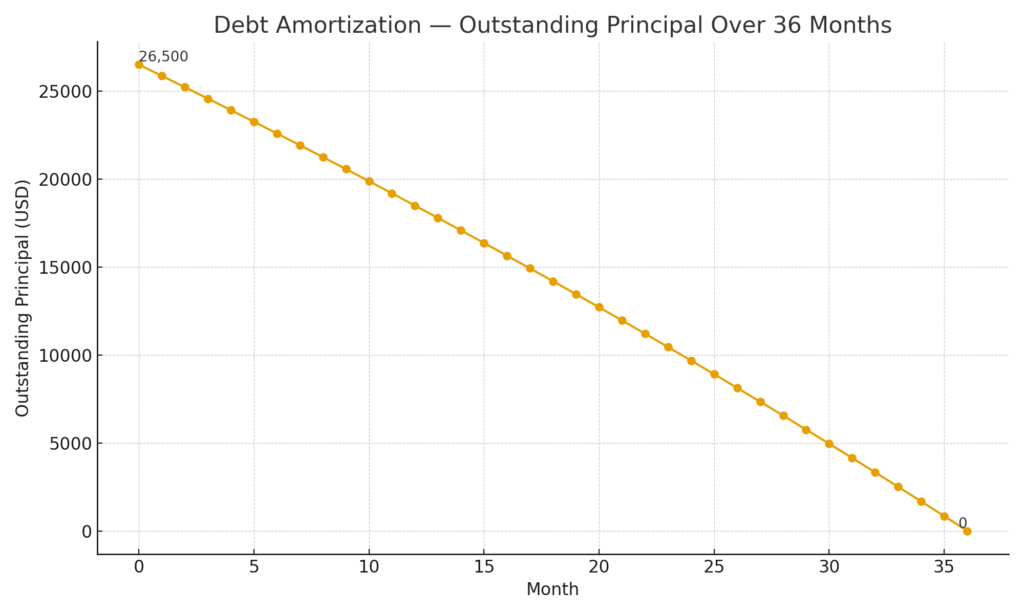
Risk Analysis and Mitigation Plan
Purpose. Name the real risks, not the imaginary ones—and show the playbook for when they show up.
Key Risks
- Economic downturns. Households trim discretionary services; SMBs reduce cleaning frequency or square footage.
- Rising labor costs. Wage pressure and overtime can squeeze margins if pricing lags.
- Customer churn. Quality misses or schedule slips break trust; acquisition costs rise if retention slips.
- Equipment failures. Vacuum/floor gear failures slow teams and force reschedules.
- Liability or damage claims. Breakage, slip/fall, chemical misuse, or data/privacy issues (e.g., door codes).
Mitigation Strategies
- Diversified client base. Blend recurring residential with light commercial to avoid single-segment shocks; cap any one client at < 8% of monthly revenue.
- Pricing & indexation. Review rates every 6 months; add cost-of-service clauses in commercial contracts (fuel/labor index triggers).
- Training & QA. 15-hour onboarding; quarterly refreshers; room-order method; checklists; before/after photos; inspector spot checks.
- Scheduling discipline. Crew pairing for familiarity; route density targets (≥ 82% utilization); buffer slots for overruns and re-cleans.
- Insurance & legal. GL ($1M/$2M), workers’ comp, commercial auto, janitorial bond; signed scope-of-work and exclusions; documented SDS/PPE.
- Equipment redundancy. Maintain spare HEPA vacuums and extra microfiber inventory; preventive maintenance calendar.
- Data & access security. Encrypted storage of codes; key custody logs; change codes on offboarding.
Contingency Planning
| Trigger | Immediate Action | Owner | Financial Backstop |
|---|---|---|---|
| Revenue dip ≥ 15% for 2 consecutive months | Freeze nonessential spend, shift ad mix to high-intent search, push retention bundles to base clients | CEO | Operating reserve equal to 1.5× monthly fixed costs; optional ad line reallocated to promotions |
| Labor gap ≥ 1 crew for > 1 week | Activate vetted subcontractors; offer overtime credits to crews; temporarily throttle new leads | COO | $1,500/mo contingency for temp/sub premiums |
| Major equipment failure | Swap to spare units; same-day repair ticket; reroute jobs to keep SLA | COO | $250/mo maintenance reserve + supplier net-30 |
| Quality incident (re-clean or damage claim) | 48-hour re-clean; claim filed within 24h; client update within 12h; coach crew | Inspector | Insurance; $500 goodwill reserve/month |
| PR or safety issue | Crisis script; single spokesperson; pause ads; internal brief and corrective action report in 48h | CEO | Legal retainer on-call; documented SOPs |
Emergency fund & credit. Keep a standing reserve equal to ~1.5× monthly fixed costs (≈ $11,000–$12,000) and a small business credit line for timing hiccups (commercial AR). The goal is dull finances: stable service, no panicked cuts, and zero skipped paydays.
Growth & Expansion Plan
Purpose. Lay out how we scale without breaking the machine: more routes, tighter density, new revenue lines, and smarter tooling.
Geographic expansion. We grow like a stain on a map—outward from the routes that already work.
- Phase 1 (Months 12–18): Add coverage in North Fulton (Alpharetta, Johns Creek) and East Cobb. Goal: +2 route days/week; add 1 two-person crew when utilization holds ≥ 85% for 6 weeks.
- Phase 2 (Months 18–30): Push into Sandy Springs–Buckhead and Decatur. Lock 8–10 steady SMB office contracts before adding second inspector.
- Phase 3 (Months 30–42): Southside nodes (Airport corridor) using satellite storage (roll-in cage + locked cabinet) to cut deadhead miles.
Franchising or licensing model. Only when the playbook is boringly repeatable.
- Prerequisites: Rolling 12-month NPS ≥ 70, QA pass ≥ 95%, on-time ≥ 95%, and unit-level EBITDA ≥ 18% at ≥ 3 locations/routes clusters.
- Pilot: License the brand + SOPs to an operator with janitorial background. Royalty 6% of gross + 1% brand fund; initial training + quarterly audits.
- Toolkit: Route density targets, scope libraries, pricing sheets, recruiting templates, QA photo standards, and franchisee dashboard.
Diversification. Add lines that ride the same crews or share the same customers.
- Carpet & upholstery: Lift attach rate to 25% on residential deep cleans; bundle with move-outs.
- Light janitorial add-ons: Day-porter hours, supply restock management, quarterly floor care (VCT scrub/recoat).
- Maid services / organization blocks: Optional 2-hour add-ons for laundry fold and pantry closets; capacity-based release only.
- Seasonal: Interior windows, oven/fridge bundles before holidays; post-renovation cleans with contractor partners.

Technology upgrades. Buy back minutes; minutes turn into margin.
- Dynamic routing: Upgrade to auto-dispatch with traffic and time-on-task learning; goal: −10% drive time per job.
- Ops dashboard: Live SLA board (en route / on site / done), re-clean triggers, and crew scorecards tied to bonuses.
- Quoting engine: Square footage + room count + soil factor → instant price bands; reduces back-and-forth and discount leakage.
- Data layer: Job-costing by service type and channel; CAC:LTV tracked weekly; automatic pause/skip workflows to reduce churn.
Sustainability initiatives. Good for customers, crews, and margins.
- Zero-waste tilt: Refillable concentrates, durable spray heads, color-coded microfiber with controlled par levels.
- Fleet: Route density first; then hybrid/EV adoption as replacement cycles hit—start with one plug-in for urban loops.
- Chemical governance: SDS library with green-first defaults; escalate to hospital-grade only when scope demands (document consent).
Mileposts. Revenue run-rate $500k (Month ~24) → add 4th crew. At $750k (Month ~36) → second inspector and satellite storage. At $1.0M (Month ~42–48) → evaluate first licensed operator in an adjacent metro.
Appendix
- Legal documents. State LLC registration, local business license, general liability and workers’ compensation certificates, janitorial bond, vehicle insurance cards.
- Team resumes. CEO and COO resumes (ops, QA, safety), inspector profile, sample training log for new hires.
- Sample contracts. Residential scope & exclusions; commercial janitorial agreement with service levels, cost-of-service indexation clause, and 30-day termination language.
- Marketing materials. One-page service menu, route-area flyer, brand guide (logo usage, colors, tone), before/after photo set.
- Equipment list. HEPA vacuums (x6), carpet extractor, floor machine (175 RPM), color-coded microfiber par levels, PPE, chemical concentrates with dilution ratios, window kits.
- Additional charts & data. Year-1 monthly revenue and cash flow charts; break-even worksheet; route density map; KPI dashboard mockups (on-time, QA pass, re-clean rate, NPS).
Here’s clean **JSON-LD** you can drop into the `
` of the page:“`html
“`

